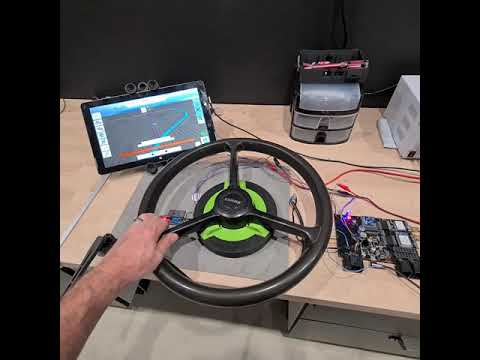Hello,
I’m new to AgOpenGPS and just ordered some components, but until now just played with simulator mode. I want to try using a DC motor connected to the steering wheel with some gears. I wonder if I always have to physically disengage the motor from the steering wheel if I want to turn it by hand, for example if there is a tree in the field or if I want to turn manually on headlands. Am I right, and would there be any possibility to achieve some kind of auto-disengagement?
Greetings from Germany
Bennet
That depends on the motor and motor driver.
A motor with a low reduction gear set and a motor driver that not shorten the motor if disabled results in low “friction” => usable.
Too many gears in the motor or “wrong” motor driver, and it gets harder.
Also the motor driver has to be able to let the motor coast.
I ordered the Cytron MD13S motor driver. I understand that the motor has to be free to rotate when autosteer is turned off. But how does AgOpenGPS know that I turn the steering wheel? Do I have to manually turn autosteer off? It seems pretty easy when you use direct control of the orbitrol, but that wont be possible for me.
Not quite relevant to the question, but I saw the new greg system (Farmtek) which piqued my curiosity. What technology can be used to detect user grip? I have another electric motor application where it could be useful …
You can see it in action here:
I know that more expensive motor servos like the ClearPath motors can give you that kind of information.
hub drive - just an idea
You should always be able to turn by hand. For that, the Cytron is 2nd best. Better choice is the IBT2 which can set both half-bridges tristated. Although easily possible to detect (WAS input != PWM output), I know no solution for an automatic disable.
more likely: large hollow shaft ultra low speed disc DC brushless motor motor Flat thin Multipole with Hall
wouldnt it be possible to attach a rotary encoder to the steering wheel or the motor and measure how fast it turns in normal operation, autosteer enabled, so you got a reference to the input signal generated by the software. When I now turn the steering wheel by hand it should differ from its reference value by eg 20% and sends a signal, just like a switch, to the software which disables autosteer. Should be possible with a simple arduino or am wrong?
Edit: Last year I worked on a farm where they had an old tractor with autosteer and an electric steering wheel, which I had to turn a bit to disable autosteer, guess that could work kind of the same way
as AOG needs a WAS, there is no need to install an encoder for disabeling, when using a steering wheel motor. The information is the same. Another option: analyzing the motor current (IBT2 has a sensor output for that), but as I said, I don’t know any implementation.
I know that I need a WAS on the axle, but I dont need to know at what angle my steering wheel is, right? If I would compare the angle or the speed of the steering wheel to the expected speed or angle given by the motor driver (or directly the software?), it should be relatively easy to measure a difference and tell AgOpenGPS to stop autosteer. To analyze the motor current would be kind of the same thing, just with other data, but that might even be the better way. So there is no implemented solution, I’d have to create something myself, or at least try to ![]()
keep us tuned! ![]()
In your first post you mention you are new here, so I think I should mention the possibility of using a footswitch, either separate or by using switch on brake or clutch, connected to steer switch input on pcbv2
Didnt think about that, that would be possible too. I have been working for three years now with commercial solutions on other farms and found it to be quite handy being able to disable autosteer exactly when I want to steer manually, especially when working around obstacles. But thank you for your hint, especially because i want to use the pcbv2!
What about human capacitive touch of steering wheel.
When the steering motor is active, it should difficult to move it. The H bridges would either be driving it or braking it. Should be possible to measure the current to tell when it’s being moved by hand against that. I would think manual movement would cause a noticeable spike in the current. Not sure how to measure that. Maybe a hall sensor of some kind? Apparently an ACS712 current sensor is available up to 20 amps.
companies like Audi really have a touch at the steering wheel, but unlike a tractor, they have electronic for all the keys there anyway and with that a power supply/data lines.
@torriem That’s not correct by 100%. You’re right for the Cytron motor driver, that has only direction and PWM signals. The IBT2 has PWM and Enable independently for both output stages, although AOG puts two of them togeteher. With that, you can tristate the stage, leading to significantly reduced torques. Nice description of the priciples can be found here: Datasheet TI DRV8844, chapter 7.3.3
Would that work with a plastic flywheel or whatever material used? How to measure the capacity above? and how to connect a steering wheel that turns? It would be a good solution but the how to do it seems complex to me
I think of a metal type tape on the underside of steering wheel.
Could be battery operated over Bluetooth, or tape around center and a “brush /coal” to read like on a car.
